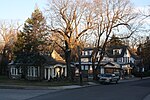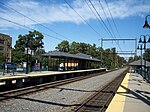Old York Road
Old York Road (originally York Road) is a roadway that was built in the 18th century to connect Philadelphia with New York City. Through New Jersey it was built along the Raritan (Unami tribe) "Naraticong Trail", also known as the Tuckaraming Trail. A memorial plaque to the friendship of the Naraticong Indians, who permitted the road to be built over their trail, sits at the intersection of Old York Road and Canal in Raritan, NJ. The Swift Sure Stage Coach Line completed the journey between the two cities in two days and cost only a few dollars. A ferry left Elizabethtown Point for New York City, or passengers could continue onto Newark and ultimately Powles Hook Ferry (present day Exchange Place in Jersey City) via Bergen Point Plank Road/Newark Plank Road.
Excerpt from the Wikipedia article Old York Road (License: CC BY-SA 3.0, Authors).Old York Road
Cheltenham Avenue, Cheltenham Township
Geographical coordinates (GPS) Address Nearby Places Show on map
Geographical coordinates (GPS)
| Latitude | Longitude |
|---|---|
| N 40.062 ° | E -75.136 ° |
Address
Cheltenham Avenue
Cheltenham Avenue
19126 Cheltenham Township
Pennsylvania, United States
Open on Google Maps









